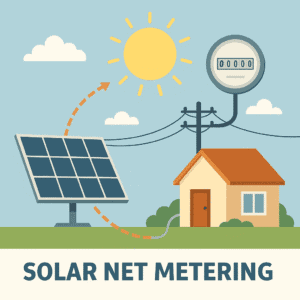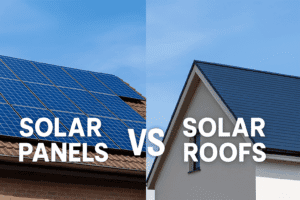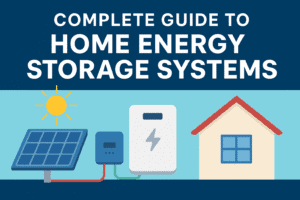Solar Battery Storage: Is It Worth It in 2025?
As solar panel adoption continues to rise, many homeowners are asking: is solar battery storage worth it in 2025? With prices falling and battery technology improving, solar batteries are becoming a more viable addition to home energy systems. They offer backup power during outages, reduce electricity bills by shifting usage to off-peak periods, and maximize solar self-consumption, especially with time-of-use tariffs and expanding renewable incentives.
This guide explores everything you need to know, types of solar batteries, sizing and cost breakdowns, financial analysis, installation considerations, pros and cons, and a step-by-step decision framework.
You’ll also find linked insights to support your solar journey:
- Installing Solar Panels vs Solar Roofs: Solar Panels vs Solar Roofs: Which is Better for Your Home?
- Optimizing Energy Efficiency: The Ultimate Guide to Home Energy Efficiency in 2025: Save Money & Boost Comfort
- Solar Installation Incentives: How to Perform a Home Energy Audit: Step-by-Step Guide
With a fully integrated system combining solar and solar battery storage, your home can be more resilient, eco-friendly, and cost-effective in the years ahead.

What Is Solar Battery Storage?
Solar battery storage refers to a system that captures electricity generated by solar panels and stores it in a battery for later use. This storage allows homeowners to:
- Use solar power during non-sunlight hours
- Stay powered during grid outages
- Shift consumption to lower-cost usage windows
- Improve self-consumption rates
- Potentially earn incentives through grid services
Types of Solar Battery Technologies
A. Lithium-Ion Batteries
- Chemistry: Lithium Nickel Manganese Cobalt (NMC) or Lithium Iron Phosphate (LFP)
- Pros: High energy density, long lifespan (10–15 years), high efficiency (90–95%)
- Cons: Higher price point, fire risk without proper Management Systems (BMS)
B. Lead-Acid Batteries
- Types: Flooded and Absorbed Glass Mat (AGM)
- Pros: Lower upfront cost, proven technology
- Cons: Heavy, short lifespan (3–5 years), low depth of discharge (~50%), maintenance needed
C. Flow Batteries (Emerging)
- Chemistry: Vanadium redox flow or zinc-bromine
- Pros: Long cycle life, scalable, non-flammable
- Cons: High cost, less market availability
D. Saltwater & Other Chemistries
- Pros: Safe, environmental-friendly
- Cons: Low energy density, higher costs—still gaining adoption
Key Specifications Explained
A. Capacity vs Usable Capacity
- Rated capacity vs usable capacity is important. A 13.5 kWh battery with 90% usable capacity gives roughly 12 kWh of usable energy.
- Use Depth of Discharge (DoD) to plan for battery longevity and repeated cycles.
B. Round-Trip Efficiency
- Lithium-ion offers ~90–95% efficiency; lead-acid offers ~70–80%. Higher efficiency means less loss during charge/discharge.
C. Cycle Life & Warranty
- Most solar batteries carry 10-year or 4,000-cycle warranties. Longer cycle life means better long-term value.
D. Charge Rates & Integration
- Maximum charge/discharge rates impact how quickly batteries can be utilized. Check inverter and system compatibility.
Use Cases: Who Benefits Most?
Solar battery storage shines for:
- Homes with frequent power outages
- Areas with high peak electricity prices
- Time-of-use (TOU) rate plans
- Off-grid or recreational properties
- EV owners using solar power for charging
Locations with rolling blackouts or TOU rates—often like California—see the most value from solar battery storage.
Cost Analysis
A. System Cost Breakdown
| Component | Estimated Cost (US) |
|---|---|
| Battery (e.g. Powerwall 3) | $10–12k installed |
| Inverter / ESS Integration | $2–5k |
| Permits & labor | $1–3k |
| Total | $13–20k |
B. Incentives & Rebates
- Federal ITC offers 30% credit on battery systems.
- Some utilities offer rebates for backup batteries.
- Local and state programs may add savings.
C. Payback and ROI
- Target payback period: <10 years
- Savings come from avoided bills, TOU arbitrage, backup benefits
- Example scenario: 13 kWh battery + TOU rate savings often yield 7–10 year payback
Installation & Integration
A. System Components
- Solar panels
- Battery unit(s)
- Inverter/ESS or hybrid inverter
- Wiring and mounting hardware
- Optional transfer switch for backup
B. Installation Checklist
- Ensure code-compliant permitting and inspections
- Consider ventilation and fire-safety (NEC 2023 battery section 706)
- Use professional installers on list—NABCEP certification recommended
C. Microgrid and Island Capability
Some systems—e.g. Tesla Powerwall—support true islanding: letting you power up during grid outages. Check for UL 9540 approval.

Pros & Cons of Solar Battery Storage
Pros
- Backup power during outages
- Maximizes solar self-consumption
- Reduces electricity bills, especially under TOU rates
- Smooths energy demand on the grid
- Adds property value
Cons
- High upfront cost
- Complexity in installation
- Regular maintenance and monitoring
- Long payback timelines
- Warranty limitations
For most homes, adding solar battery storage alongside solar panels becomes cost-effective in specific scenarios (e.g., outages, TOU rates).
Financing & Leasing Options
Many companies offer financing plans for solar + battery systems—UPS-backed leases or Power Purchase Agreements (PPA). Compare options carefully:
- Check interest rates
- Evaluate maintenance obligations
- Consider property and system ownership
Case Studies
A. Suburban Home with TOU Rates
- Panels + 13 kWh battery
- Saved $500/year using peak shaving
- Net payoff in ~8 years (with ITC)
B. Rural Home With Blackouts
- Tesla + Generac backup
- $2k annual benefit
- Quick ROI due to reliable backup
Levelization: Sizing Your Battery
A. How much storage do you need?
- Tier 1: 5 kWh—essential night-time backup
- Tier 2: 13–18 kWh—full-day backup and daily TOU buffer
- Tier 3: 20+ kWh—large homes or resilience systems
B. Tools to calculate usage
- Use Sense, Emporia, or utility billing portal
- Determine average daily usage and peak times
Maximizing Value by Combining Efficiency
Pairing solar battery storage with:
- Smart thermostats (like Nest or ecobee)
- Energy storage–aware appliances
- Whole-home energy monitoring
- Heat-pump and EV charging systems
Make your solar+battery system smarter and more cost-effective.
Challenges and Future Trends
A. Battery Recycling & Safety
- Lithium batteries are recyclable (lithium-ion recovery initiatives)
- Proper fire-rated enclosures (NFPA 855/UL 9540) are essential
B. Emerging Technologies
- Flow batteries growing in commercial projects
- Vehicle-to-grid (V2G) and inter-home battery sharing
- AI-based home energy management systems
Checklist Before You Invest
- Assess power outage risk and grid resiliency
- Examine utility rate structures
- Estimate storage requirements—kWh, cost, payback
- Investigate rebates and permitting rules
- Gather 3–5 installer quotes
- Choose brands with strong warranties and support
- Plan appliance load to smartly use stored energy
FAQs
Is solar battery storage worth it in 2025?
Yes—solar battery storage can be worth it in 2025 in areas with time-of-use rates, frequent outages, or high electricity prices. After federal and local incentives, many homeowners see payback within 7–10 years.
How long do solar battery systems last?
Lithium-ion solar batteries typically last 10–15 years or 4,000–6,000 cycles, depending on depth of discharge. Warranties often cover 70–80% capacity over 10 years.
Can I go off-grid with battery storage?
Yes—if sized properly. Off-grid battery systems require more capacity (20+ kWh) and backup generators. Grid-tied systems with islanding capability (like Tesla Powerwall) offer partial off-grid resilience without total independence.
What does solar battery storage cost in 2025?
Installed residential systems typically cost between $13k–$20k before incentives. A 13.5 kWh system (e.g., Tesla Powerwall) often comes around $14k after combining component & labor costs.
In Summary
- Is solar battery storage worth it in 2025? Absolutely—where incentives, outages, and TOU rates align.
- Choose lithium-ion batteries for high efficiency and longer life.
- Size carefully—start with 5 kWh and scale up as needed.
- Smart integration with efficiency strategies amplifies savings.
- Monitor and maintain your system to ensure longevity and safety.






